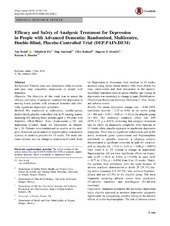| dc.contributor.author | Erdal, Ane | en_US |
| dc.contributor.author | Flo, Elisabeth | en_US |
| dc.contributor.author | Aarsland, Dag | en_US |
| dc.contributor.author | Ballard, Clive | en_US |
| dc.contributor.author | Slettebø, Dagrun Daltveit | en_US |
| dc.contributor.author | Husebø, Bettina | en_US |
| dc.date.accessioned | 2019-07-29T10:03:10Z | |
| dc.date.available | 2019-07-29T10:03:10Z | |
| dc.date.issued | 2018-06 | |
| dc.Published | Erdal A, Flo E, Aarsland D, Ballard C, Slettebø DD, Husebø BS. Efficacy and Safety of Analgesic Treatment for Depression in People with Advanced Dementia: Randomised, Multicentre, Double-Blind, Placebo-Controlled Trial (DEP.PAIN.DEM). Drugs & Aging. 2018;35(6):545-558 | eng |
| dc.identifier.issn | 1170-229X | |
| dc.identifier.issn | 1179-1969 | |
| dc.identifier.uri | https://hdl.handle.net/1956/20575 | |
| dc.description.abstract | Background Chronic pain and depression often co-occur, and pain may exacerbate depression in people with dementia. Objective The objective of this study was to assess the efficacy and safety of analgesic treatment for depression in nursing home patients with advanced dementia and clinically significant depressive symptoms. Methods We conducted a multicentre, parallel-group, double-blind, placebo-controlled trial in 47 nursing homes, including 162 nursing home patients aged ≥ 60 years with dementia (Mini-Mental State Examination ≤ 20) and depression (Cornell Scale for Depression in Dementia ≥ 8). Patients were randomised to receive active analgesic treatment (paracetamol or buprenorphine transdermal system) or identical placebo for 13 weeks. The main outcome measure was the change in depression (Cornell Scale for Depression in Dementia) from baseline to 13 weeks, assessed using linear mixed models with fixed effects for time, intervention and their interaction in the models. Secondary outcomes were to assess whether any change in depression was secondary to change in pain (Mobilisation-Observation-Behaviour-Intensity-Dementia-2 Pain Scale) and adverse events. Results The mean depression change was − 0.66 (95% confidence interval − 2.27 to 0.94) in the active group (n = 80) and − 3.30 (− 4.68 to −1.92) in the placebo group (n = 82). The estimated treatment effect was 2.64 (0.55–4.72, p = 0.013), indicating that analgesic treatment had no effect on depressive symptoms from baseline to 13 weeks while placebo appeared to ameliorate depressive symptoms. There was no significant reduction in pain in the active treatment group (paracetamol and buprenorphine combined) vs. placebo; however, a subgroup analysis demonstrated a significant reduction in pain for paracetamol vs. placebo [by − 1.11 (− 2.16 to − 0.06, p = 0.037)] from week 6 to 13 without a change in depression. Buprenorphine did not have significant effects on depression [3.04 (− 0.11 to 6.19), p = 0.059] or pain [0.47 (− 0.77 to 1.71), p = 0.456] from 0 to 13 weeks. Thirty-five patients were withdrawn from the study because of adverse reactions, deterioration or death: 25 (31.3%) during active treatment [23 (52.3%) who received buprenorphine], and ten (12.2%) in the placebo group. The most frequently occurring adverse events were psychiatric (17 adverse reactions) and neurological (14 adverse reactions). Conclusion Analgesic treatment did not reduce depression while placebo appeared to improve depressive symptoms significantly by comparison, possibly owing to the adverse effects of active buprenorphine. The risk of adverse events warrants caution when prescribing buprenorphine for people with advanced dementia. | en_US |
| dc.language.iso | eng | eng |
| dc.publisher | Springer | eng |
| dc.rights | Attribution CC BY-NC | eng |
| dc.rights.uri | http://creativecommons.org/licenses/by-nc/4.0/ | eng |
| dc.title | Efficacy and Safety of Analgesic Treatment for Depression in People with Advanced Dementia: Randomised, Multicentre, Double-Blind, Placebo-Controlled Trial (DEP.PAIN.DEM) | en_US |
| dc.type | Peer reviewed | |
| dc.type | Journal article | |
| dc.date.updated | 2019-01-27T17:46:15Z | |
| dc.description.version | publishedVersion | en_US |
| dc.rights.holder | Copyright 2018 The Author(s) | |
| dc.identifier.doi | https://doi.org/10.1007/s40266-018-0546-2 | |
| dc.identifier.cristin | 1636451 | |
| dc.source.journal | Drugs & Aging | |

